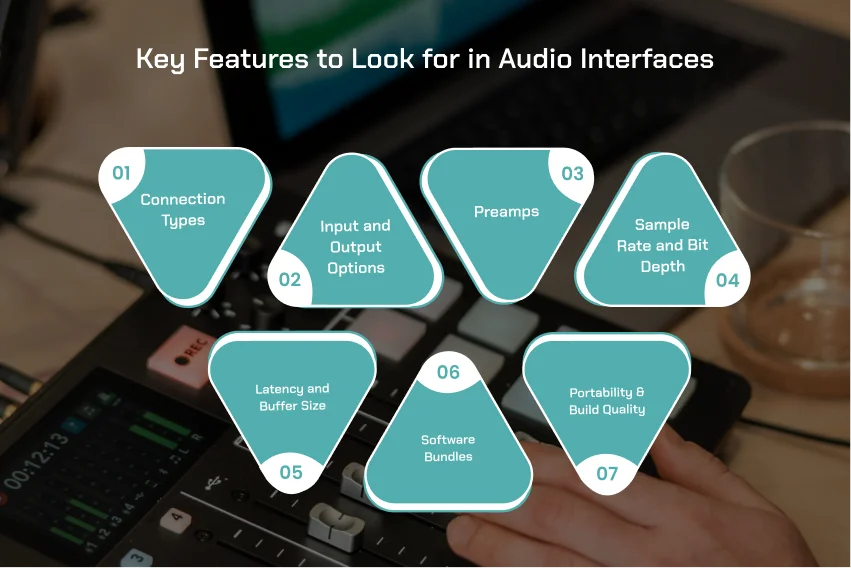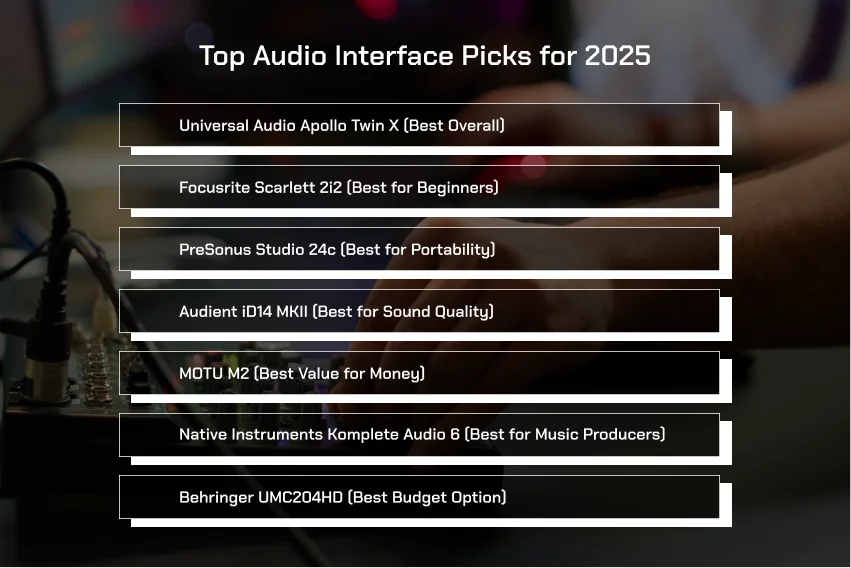Audio interfaces are crucial for achieving high-quality recordings in music production. Whether you’re a professional producer, an aspiring musician, or a podcaster, the quality of your audio interface directly impacts the clarity and detail of your recordings.
In this guide, we’ll explore the importance of choosing the best audio interface for your needs in 2025. With new technologies and models emerging each year, selecting the right interface can be daunting.
However, understanding key features and knowing what to look for can ensure that you make an informed decision.
Read More About What Is The Best Audio Interface For Professional Recording?
What is an Audio Interface?
An audio interface is a hardware device that converts sound signals into digital data that your computer can process. It acts as a bridge between your microphones, instruments, and the computer, enabling the recording and playback of high-quality audio. Audio interfaces come in various types, each offering specific features and benefits depending on the user’s needs.
- USB: The most common and affordable type of connection, compatible with almost all computers.
- Thunderbolt: Provides faster data transfer speeds, ideal for professional setups requiring low latency.
- FireWire: Less common but still used in some legacy systems.
Each type of connection has its own advantages, depending on your setup and workflow.
Why is a Good Audio Interface Important for Recording?
A high-quality audio interface plays a pivotal role in ensuring your recordings are clean, clear, and accurate. Here’s why a good interface matters:
- Sound Quality: High-quality converters ensure your recordings maintain clarity and precision, minimizing distortion and artifacts.
- Low Latency: A crucial factor for real-time monitoring during recording, especially for musicians or voiceover artists who need to hear themselves without delay.
- Preamps: Built-in preamps allow microphones or instruments to be powered correctly. Interfaces with high-quality preamps help achieve better recordings and improve sound capture.
Without a good audio interface, even the best microphones and instruments won’t perform at their full potential.
| Unlock the Best Rap Beats for Your Tracks TodayGet exclusive access to high-quality rap beats from JBZ Beats. Perfect for elevating your music and standing out in the industry. |
Key Features to Look for in Audio Interfaces (2025)

When shopping for an audio interface in 2025, here are some key features you should consider:
Connection Types
USB and Thunderbolt are the most common connections, but you should choose based on your computer’s compatibility.
Thunderbolt offers faster data transfer, which is important for professional studios requiring low-latency recording.
Input and Output Options
Inputs: Look for the number and types of inputs you need (e.g., mic, line, instrument, MIDI).
Outputs: Ensure the interface has the necessary output channels to connect to your studio monitors or headphones.
Connector Types: Choose interfaces with connectors like XLR for microphones, TRS/TS for instruments, and MIDI for music production.
Preamps
High-quality preamps are essential for clean recordings, especially for microphones. Some interfaces also offer phantom power for condenser mics.
Sample Rate and Bit Depth
24-bit/192kHz or higher provides superior audio quality for recording and mixing.
Ensure your interface supports high sample rates to maintain audio fidelity.
Latency and Buffer Size
Low latency is essential for real-time recording. Check for interfaces that offer low-latency performance and adjustable buffer sizes to avoid unwanted delays.
Software Bundles
Many audio interfaces come with DAW (Digital Audio Workstation) software and plugins. Ensure the interface is compatible with your preferred DAW.
Portability and Build Quality
If you plan on recording on the go, consider a compact, durable interface that can withstand the rigors of travel.
Read More About The Best Audio Interface For 2020, 2021 (And On)
Top Audio Interface Picks for 2025

1. Universal Audio Apollo Twin X (Best Overall)
Key Features: Exceptional sound quality, low latency, Unison preamps, and professional-grade converters.
Pros: Ideal for high-end studios, offers extensive software integration, and superior audio quality.
Cons: Expensive; may be overkill for beginners.
Why It’s a Top Choice: Known for its pristine audio quality, it’s ideal for musicians and producers seeking professional-level recordings.
2. Focusrite Scarlett 2i2 (Best for Beginners)
Key Features: Affordable, excellent sound quality, and easy to use.
Pros: Great for entry-level studios, includes software bundle, and provides two high-quality preamps.
Cons: Limited inputs for more complex setups.
Why It’s a Top Choice: Focusrite is trusted for delivering solid audio interfaces for budget-conscious creators.
3. PreSonus Studio 24c (Best for Portability)
Key Features: Compact design, USB-C connectivity, and solid preamps.
Pros: Very portable and durable, great sound quality.
Cons: Limited inputs and outputs.
Why It’s a Top Choice: Ideal for musicians or podcasters who need a mobile setup with professional sound.
4. Audient iD14 MKII (Best for Sound Quality)
Key Features: Superb preamps, great converters, and compact design.
Pros: Exceptional clarity and quality, great for both home studios and professionals.
Cons: Doesn’t offer as many inputs as other models.
Why It’s a Top Choice: Its high-end preamps and converters make it an excellent choice for users prioritizing sound fidelity.
5. MOTU M2 (Best Value for Money)
Key Features: Transparent preamps, excellent sound, and low latency.
Pros: Affordable, great audio quality, and easy setup.
Cons: Limited software bundles.
Why It’s a Top Choice: Great balance between price and performance for those who don’t want to compromise on sound quality.
6. Native Instruments Komplete Audio 6 (Best for Music Producers)
Key Features: MIDI connectivity, seamless integration with music production software.
Pros: Ideal for producers looking for MIDI compatibility and music production software integration.
Cons: Lacks high-end preamps.
Why It’s a Top Choice: Provides great value for producers, with additional software and hardware integrations for music creation.
7. Behringer UMC204HD (Best Budget Option)
Key Features: Affordable, durable, with decent preamps.
Pros: Great for beginners or budget-conscious producers.
Cons: Build quality may feel less premium.
Why It’s a Top Choice: Offers impressive audio performance at an unbeatable price for new creators.
| Take Your Music to the Next Level with JBZ BeatsDon’t miss out on the hottest rap beats. Whether you’re a beginner or a pro, JBZ Beats offers the perfect beats to fuel your creative vision. |
How to Choose the Right Audio Interface for Your Needs
For Home Studios:
Prioritize affordability and ease of use. Focus on sound quality, ease of setup, and software compatibility.
For Professional Studios:
Opt for interfaces with multiple inputs, high sample rates, and reliable build quality. Look for options offering flexibility in terms of expansion and software compatibility.
For Musicians on the Go:
Portability is key. Look for lightweight, compact, and durable interfaces that don’t compromise on audio quality.
For Podcasters and Streamers:
Choose interfaces with multiple inputs, headphone monitoring capabilities, and easy-to-use controls for live streaming or podcast recording.
Comparison Chart of Top Audio Interfaces for 2025
| Model | Inputs | Outputs | Preamps | Sample Rate | Price | Best For |
| Universal Audio Apollo X | 2 | 2 | Unison | 24-bit/192kHz | $$$$$ | Professional studios |
| Focusrite Scarlett 2i2 | 2 | 2 | Focusrite | 24-bit/192kHz | $$ | Beginners, home studios |
| PreSonus Studio 24c | 2 | 2 | XMAX-L | 24-bit/192kHz | $$ | Portability, mobile setups |
| Audient iD14 MKII | 2 | 2 | Audient | 24-bit/96kHz | $$$ | Sound quality-focused setups |
| MOTU M2 | 2 | 2 | ESS Sabre | 24-bit/192kHz | $$ | Value for money setups |
| Native Instruments Komplete Audio 6 | 2 | 2 | NI | 24-bit/192kHz | $$ | Music production, MIDI |
| Behringer UMC204HD | 2 | 2 | Behringer | 24-bit/192kHz | $ | Budget-conscious users |
Setting Up Your Audio Interface
- Connecting to Your Computer: Connect via USB, Thunderbolt, or FireWire, based on your interface’s compatibility.
- Installing Drivers and Software: Download and install any necessary drivers and DAWs.
- Testing and Troubleshooting: Ensure all connections are secure and test for sound clarity and latency. Common issues include driver conflicts or incorrect settings in the DAW.
Conclusion
In conclusion, selecting the right audio interface in 2025 is key to achieving high-quality recordings that suit your specific needs. Whether you’re just starting out or have a professional setup, factors like connection type, preamps, and sample rate will impact your sound.
Make the right choice and elevate your music production. And if you’re looking for the best rap beats, be sure to check out JBZ Beats for top-quality rap beats on sale online!
FAQs
What is the best budget audio interface for home recording?
For home recording on a budget, the Behringer UMC204HD is a great option. It offers solid performance with high-quality audio, multiple inputs, and an affordable price tag, making it a top pick for hobbyists and beginners.
Do I need a high-end audio interface for home recording?
No, you don’t need a high-end audio interface unless you have specific requirements like multiple inputs, premium preamps, or extremely high sample rates. For most home recording setups, an affordable interface like the Focusrite Scarlett 2i2 or Behringer UMC204HD should be sufficient.
What’s the difference between USB and Thunderbolt audio interfaces?
The primary difference between USB and Thunderbolt interfaces is speed. Thunderbolt offers faster data transfer rates, resulting in lower latency and higher stability, which is ideal for professionals who need to record or mix at high quality in real-time. USB interfaces are more common and affordable, but may not offer the same performance as Thunderbolt in demanding setups.
How do I choose between an audio interface with 2 or more inputs?
If you plan on recording multiple instruments or microphones simultaneously, a 2-input interface (like the Focusrite Scarlett 2i2) is usually sufficient for simple setups. However, if you need to record a band or multiple sources at once, consider an interface with more inputs such as 4 or more for greater flexibility.
Is it worth upgrading my current audio interface?
Upgrading your audio interface is worth it if you need better sound quality, lower latency, more input options, or advanced features. If you’re experiencing limitations with your current setup (like poor preamps or compatibility issues), it might be time to consider an upgrade to an interface that suits your growing needs.


